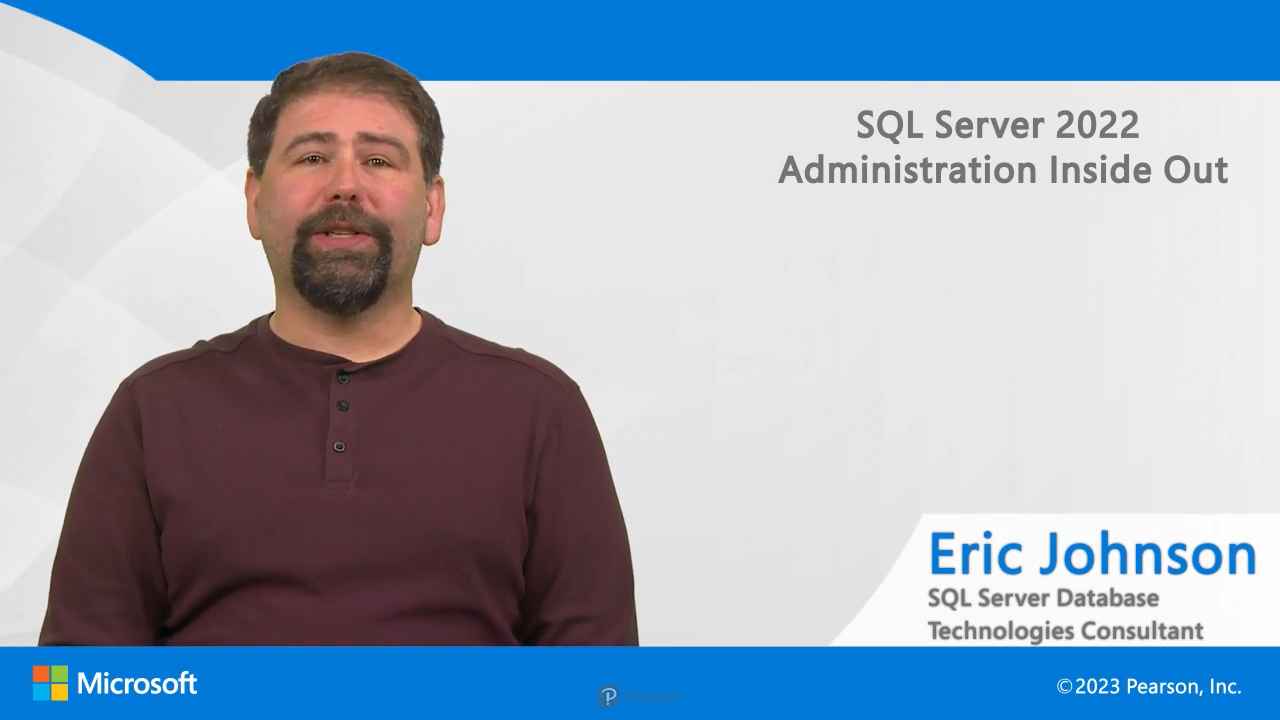SQL Server 2022 Administration Inside Out (Video)
- By Eric Johnson
- Published Feb 10, 2023 by Microsoft Press.
Online Video
- Your Price: $159.99
- List Price: $199.99
- About this video
Video accessible from your Account page after purchase.
Register your product to gain access to bonus material or receive a coupon.
Description
- Copyright 2023
- Edition: 1st
- Online Video
- ISBN-10: 0-13-811412-9
- ISBN-13: 978-0-13-811412-1
12+ Hours of Video Instruction
A comprehensive guide to provisioning, managing, and securing SQL Server 2022 databases
Get the tools you need to manage SQL Server in your environment. Learn about new features in SQL Server 2022, including how to provision SQL Server and Azure SQL databases; secure data and databases; design, tune, and optimize SQL Server; implement high-availability servers; monitor database backups and logs; and automate administration with PowerShell.
Throughout the video, instructor Eric Johnson explains the concepts and methodologies of managing SQL Server databases from the inside out and then puts techniques into practice with visual demonstrations. With Eric as your guide, follow his detailed steps and get hands-on practice to become a more experienced and more efficient database administrator.
Skill Level:
All levels
Learn How To:
- Install SQL Server administration and development tools
- Setup and configure SQL Servers and Azure databases
- Secure SQL Server
- Design, Tune, and Optimize SQL Server
- Manage data recovery and ensure high availability of your servers
- Manage and monitor databases to keep servers at peak performance
- Automate server administration, including using PowerShell
Who Should Take This Course:
These video lessons are for database administrators, architects, and developers, and performance tuning experts
Requirements:
Understanding of the Windows operating system
An IT background
Previous experience with SQL Server not required
Sample Content
Table of Contents
Introduction
Module 1: Introducing SQL Server 2022 Tools and Components
Lesson 1: Installing and Using SQL Server Administration and Development Tools
Learning objectives
1.1 Understand the Installation Center
1.2 Find the tools installed with the SQL Server
1.3 Use the performance and reliability monitoring tools
1.4 Understand SQL Server Management Studio
Lesson 2: Introducing Database Server Components
Learning objectives
2.1 Configure server memory
2.2 Setup database files
2.3 Configure network settings
2.4 Setup SQL Server security
Module 2: Provisioning SQL Server and Azure SQL Databases
Lesson 3: Provisioning SQL Server SQL Databases
Learning objectives
3.1 Install a new instance
3.2 Make post-installation server configuration changes
3.3 Install and configure database features
3.4 Create SQL Server databases
Lesson 4: Provisioning Azure SQL Database
Learning objectives
4.1 Understand Microsoft Azure and database-as-a-service concepts
4.2 Provision a logical SQL Server
4.3 Provision a database
4.4 Setup security in Azure SQL databases
Module 3: Securing SQL Server
Lesson 5: Implementing and Managing SQL Server User Security and Permissions
Learning objectives
5.1 Understand logins and users
5.2 Setup permissions in SQL Server
5.3 Migrate SQL Server logins and permissions
Lesson 6: Securing the Server and Data
Learning objectives
6.1 Handle encryption in SQL Server
6.2 Setup row level security
6.3 Understand data masking
6.4 Configure SQL Server audits
Module 4: Designing, Tuning, and Optimizing SQL Server
Lesson 7: Understanding and Designing SQL Server Tables
Learning objectives
7.1 Review table design
7.2 Understand special table types
7.3 Create views
7.4 Use change tracking
7.5 Understand Change Data Capture
Lesson 8: Performance Tuning and Optimizing SQL
Learning objectives
8.1 Understand isolation levels
8.2 Use execution plans
8.3 Configure clustered indexes
8.4 Configure non-clustered indexes
8.5 Use index statistics
Module 5: Managing Data Recovery and Implementing SQL Server High Availability
Lesson 9: Developing, Deploying, and Managing Data Recovery
Learning objectives
9.1 Understand data recovery fundamentals
9.2 Understand backup devices
9.3 Understand different types of backups
9.4 Create and verify backups
9.5 Restore a database
9.6 Define a backup and recovery strategy
Lesson 10: Implementing SQL Server High Availability and Disaster Recovery
Learning objectives
10.1 Review high availability and disaster recovery technologies
10.2 Setup SQL Server Log Shipping
10.3 Replication for High Availability
10.4 Read secondary database copies
Module 6: Managing, Monitoring, and Automating SQL Server
Lesson 11: Managing and Monitoring SQL Server Databases
Learning objectives
11.1 Schedule and Monitor database backups
11.2 Deal with database corruption
11.3 Setup index maintenance
11.4 Cleanup history
11.5 Shrink databases
11.6 Monitor database activity
11.7 Use performance monitor
11.8 Monitor database logs
11.9 Use resource governor
Lesson 12: Automating SQL Server Administration
Learning objectives
12.1 Understand the components of SQL Server automated administration
12.2 Setup database maintenance plans
12.3 Use PowerShell to automate SQL Server administration
Summary
More Information

